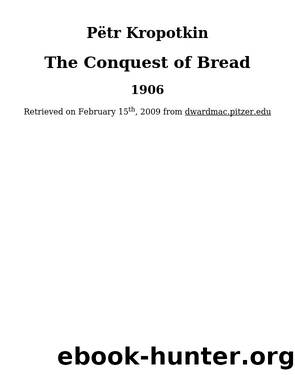The Conquest of Bread by Pëtr Kropotkin & Pëtr Kropotkin

Author:Pëtr Kropotkin & Pëtr Kropotkin
Language: eng
Format: epub
Tags: agriculture, classical
Published: 1906-08-14T16:00:00+00:00
V
And what about art? From all sides we hear lamentations about the decadence of art. We are, indeed, far behind the great masters of the Renaissance. The technicalities of art have recently made great progress; thousands of people gifted with a certain amount of talent cultivate every branch, but art seems to fly from civilization! Technicalities make headway, but inspiration frequents artistsâ studios less than ever.
Where, indeed, should it come from? Only a grand idea can inspire art. Art is in our ideal synonymous with creation, it must look ahead; but save a few rare, very rare exceptions, the professional artist remains too philistine to perceive new horizons.
Moreover, this inspiration cannot come from books; it must be drawn from life, and present society cannot arouse it.
Raphael and Murillo painted at a time when the search of a new ideal could adapt itself to old religious traditions. They painted to decorate great churches which represented the pious work of several generations. The basilic with its mysterious aspect, its grandeur, was connected with the life itself of the city and could inspire a painter. He worked for a popular monument; he spoke to his fellow-citizens, and in return he received inspiration; he appealed to the multitude in the same way as did the nave, the pillars, the stained windows, the statues, and the carved doors. Nowadays the greatest honour a painter can aspire to is to see his canvas, framed in gilded wood, hung in a museum, a sort of old curiosity shop, where you see, as in the Prado, Murilloâs Ascension next to a beggar of Velasquez and the dogs of Philip II. Poor Velasquez and poor Murillo! Poor Greek statues which lived in the Acropolis of their cities, and are now stifled beneath the red cloth hangings of the Louvre!
When a Greek sculptor chiselled his marble he endeavoured to express the spirit and heart of the city. All its passions, all its traditions of glory, were to live again in the work. But to-day the united city has ceased to exist; there is no more communion of ideas. The town is a chance agglomeration of people who do not know one another, who have no common interest, save the of enriching themselves at the expense of one another. The fatherland does not exist.... What fatherland can the international banker and the rag-picker have in common? Only when cities, territories, nations, or groups of nations, will have renewed their harmonious life, will art be able to draw its inspiration from ideals held in common. Then will the architect conceive the cityâs monument which will no longer be a temple, a prison, or a fortress; then will the painter, the sculptor, the carver, the ornament; worker know where to put their canvases, their statues, and their decorations; deriving their power of execution from the same vital source, and gloriously marching all together towards the future.
But till then art can only vegetate. The best canvases of modern artists are those that represent nature, villages, valleys, the sea with its dangers, the mountain with its splendours.
Download
This site does not store any files on its server. We only index and link to content provided by other sites. Please contact the content providers to delete copyright contents if any and email us, we'll remove relevant links or contents immediately.
Biscuits: A Savor the South Cookbook by Belinda Ellis(4215)
A Jewish Baker's Pastry Secrets: Recipes from a New York Baking Legend for Strudel, Stollen, Danishes, Puff Pastry, and More by George Greenstein(3449)
BraveTart by Stella Parks(3305)
Bake with Anna Olson by Anna Olson(3278)
Panini by Carlo Middione(3160)
Nigella Bites (Nigella Collection) by Nigella Lawson(3095)
Momofuku by David Chang(3052)
Modern French Pastry: Innovative Techniques, Tools and Design by Cheryl Wakerhauser(3028)
Bread Revolution by Peter Reinhart(2989)
The Bread Bible by Rose Levy Beranbaum(2887)
Best of Jane Grigson by Jane Grigson(2869)
Classic by Mary Berry(2833)
Sweet by Ottolenghi Yotam & Goh Helen(2804)
Martha Stewart's Baking Handbook by Martha Stewart(2676)
Flavor Flours by Alice Medrich(2643)
Betty Crocker's Good and Easy Cook Book by Betty Crocker(2598)
Sweet by Valerie Gordon(2267)
Baking by Hand by Andy King(2128)
Taste of Home Brownies & Bars by Editors at Taste of Home(2042)
